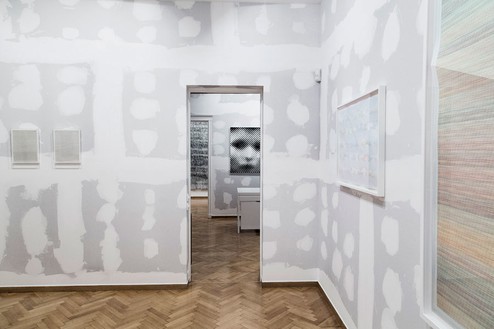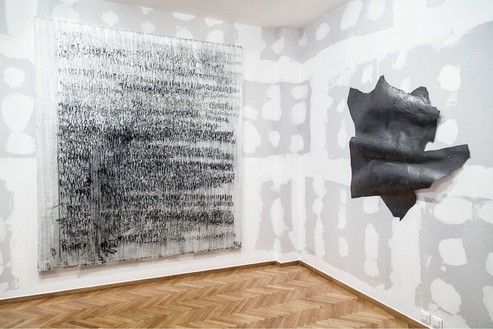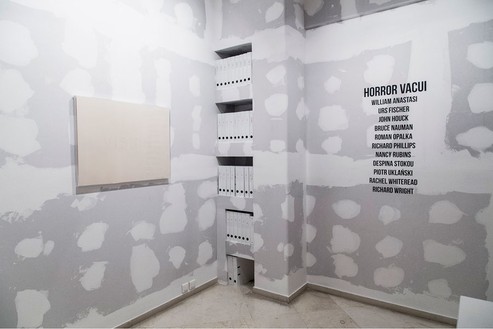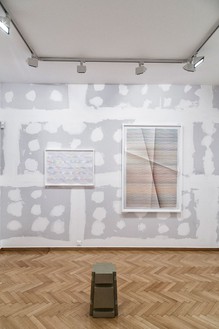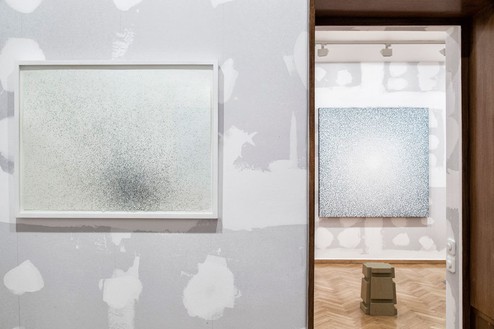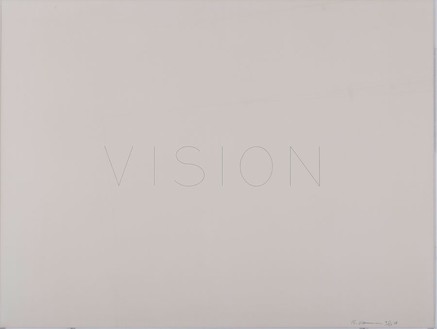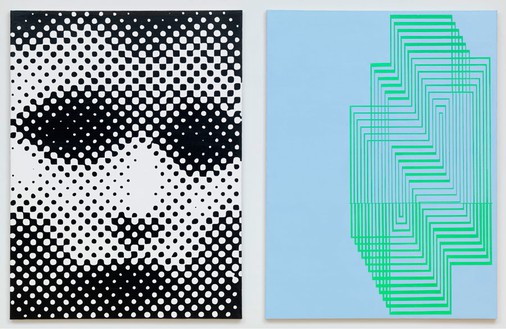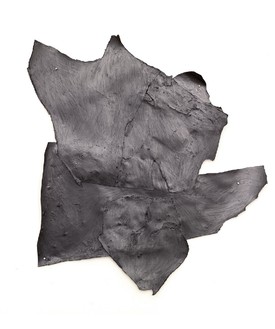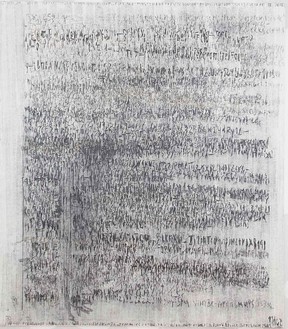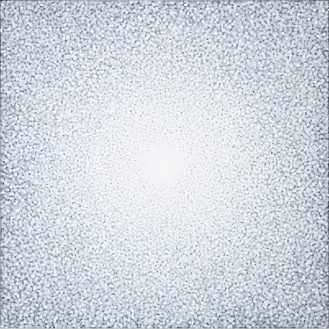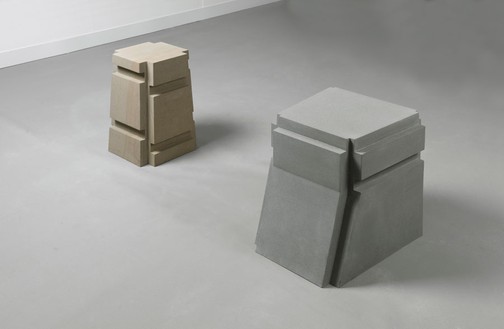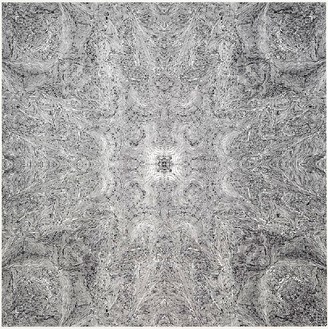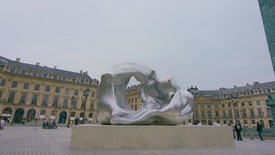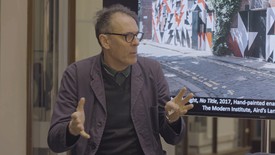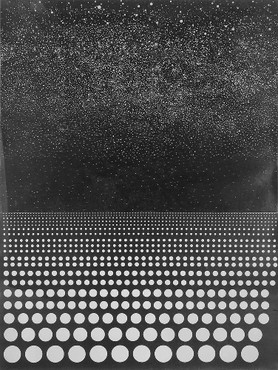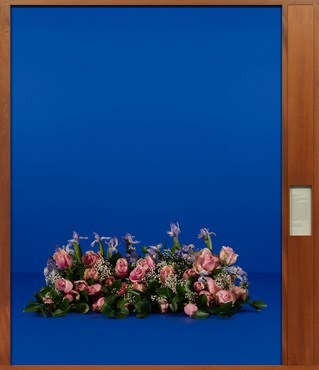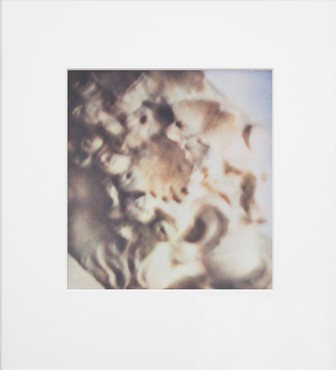About
“Horror vacui,” or “fear of empty spaces,” is a term often used to describe outsider art, where every square inch of surface is filled with details and data in a compulsive excess of activity—perhaps in fear of that blank space that might stare back. In opposing the void, every particle is given form. The group exhibition Horror vacui proposes Op art as a side effect of this embattled triage of hand, eye, and mind, where mark making is a means with which to fill space with optically rich results.
As an antidote to aesthetic gratification, Marcel Duchamp invented the Rotoreliefs in 1923. By satisfying the retina itself, they mesmerized the eye with gyrating spirals. The result was a hypnotic visual white noise as well as a false sense of depth or vortex. Duchamp enlisted his product in an inventors’ fair, sure that this would reveal its niche market demographic. Not a single Rotorelief sold.
A vacuum neutralized of the burdens of detail, the white cube has long been considered an unencumbered and timeless context for viewing art. Urs Fischer’s playful wallpaper imitates the appearance of raw sheetrock, an odd moment of past-life mimesis for the walls in a room that now communicates the sensation of an indeterminate space. The corners of rooms are where planes converge and space is rendered functionally useless and thus often ignored, yet Joel Morrison’s shiny stainless-steel corner piece converts this uselessness into a glaringly prominent strength, just as Rachel Whiteread uses the entire space itself as a sculptural material.
The hours spent applying and reapplying a totality of marks are evident in the dense graphite drawings of Nancy Rubins. Torn papers are rubbed vigorously with graphite so as to appear burnished like dull, dark metal. Made by scribbling onto the paper contained inside of his pocket with a pencil cramped in his hand, William Anastasi’s Pocket Drawings act as a diaristic account of this space within everyday attire as an active site of mark making. The late Roman Opalka spent a lifetime documenting time and space by painstakingly counting toward infinity. His works on paper entitled Cartes de Voyage demonstrate his conviction, done outside the studio out of necessity.
Ο όρος Horror vacui ή κενοφοβία χρησιμοποιείται συχνά για να περιγράψει την art brut, όπου κάθε σπιθαμή της ζωγραφικής επιφάνειας γεμίζει ασφυκτικά με λεπτομέρειες και στοιχεία στο πλαίσιο μιας δραστηριότητας που αγγίζει τα όρια της μανίας—από φόβο ενδεχομένως ότι το βλέμμα θα έρθει αντιμέτωπο με τον λευκό καμβά και την πρόκληση που αυτός αντιπροσωπεύει. Η αντίθεση στο κενό δίνει φόρμα σε κάθε μόριο ύλης. Η κενοφοβία προτείνει την Op Art ως παρενέργεια του ανταγωνισμού ανάμεσα στο χέρι, το μάτι και τη διάνοια, στο πλαίσιο του οποίου η δημιουργία σημείων αποτελεί μέσο πλήρωσης του κενού με οπτικά πλούσια αποτελέσματα.
Το 1923 ο Marcel Duchamp επινοεί τα Rotoreliefs ως αντίδοτο στην αισθητική ικανοποίηση. Ικανοποιώντας αντιθέτως τον αμφιβληστροειδή του ματιού, οι δίσκοι του Duchamp μαγνήτιζαν το βλέμμα με τις περιστρεφόμενες σπείρες τους. Το αποτέλεσμα ήταν ένα υπνωτιστικό εικαστικό ανάλογο του λεγόμενου λευκού θορύβου, καθώς και μια ψευδαίσθηση βάθους ή περιδίνησης. Ο Duchamp παρουσίασε το έργο του σε μια φουάρ εφευρετών, βέβαιος πως τα rotoreliefs του θα έβρισκαν τη δική τους θέση στην αγορά. Δεν πουλήθηκε κανένα.
Ο λευκός κύβος δεν είναι παρά ένα κενό απελευθερωμένο εδώ και καιρό από το βάρος της λεπτομέρειας, ούτως ώστε να αποτελεί πλέον ένα διαχρονικό πλαίσιο για την ανεμπόδιστη θέαση της τέχνης. Η παιγνιώδης ταπετσαρία του Urs Fischer μιμείται την όψη της γυμνής γυψοσανίδας σε ένα παράξενο στιγμιότυπο όπου οι τοίχοι ενός δωματίου—ενός απροσδιόριστου χώρου—επιστρέφουν στον πρότερο βίο τους. Οι γωνίες των δωματίων είναι σημεία σύγκλισης όπου η χρηστική αξία του χώρου ματαιώνεται. Ως εκ τούτου συχνά παραβλέπονται. Η γυαλιστερή γωνία από ανοξείδωτο ατσάλι του Joel Morrison προσδίνει μια εκτυφλωτική δύναμη στον κατά τ' άλλα άχρηστο αυτό χώρο. Η Rachel Whiteread, από την άλλη, χρησιμοποιεί τον ίδιον τον χώρο, ξεχασμένο ή αόρατο, ως γλυπτικό υλικό.
Τα πυκνά σχέδια με γραφίτη της Nancy Rubins μαρτυρούν τις ώρες που αφιερώνονται στην εμμονική εφαρμογή στον καμβά ενός συνόλου σημείων. Σκισμένα χαρτιά μουντζουρώνονται επίμονα με γραφίτη ούτως ώστε να δίνουν την εντύπωση λείου, αλλά θαμπού, σκούρου μετάλλου. Με ένα μολύβι σφηνωμένο στο χέρι και σκιτσάροντας επάνω σε χαρτιά κρυμμένα στην τσέπη του, ο William Anastasi δημιουργεί τα Pocket Drawings, μια σειρά σχεδίων-ημερολογιακών εγγραφών που καταπιάνονται με τη διερεύνηση του καθημερινού ενδύματος ως δυναμικού χώρου σημειογραφίας. Ο πρόσφατα χαμένος Roman Opalka πέρασε μια ζωή καταγράφοντας τον χρόνο και τον χώρο μετρώντας επιμελώς με στόχο το άπειρο. Τα έργα σε χαρτί με τίτλο Cartes de Voyage είναι τεκμήρια της πεποίθησής του και δημιουργήθηκαν κατ' ανάγκη εκτός του ατελιέ του.
Η ψυχαναγκαστική επανάληψη και η ασυνείδητη μουντζούρα μπορούν να αποκαλύψουν οπτικά πεδία ξεχωριστής δύναμης που δίνουν βάθος στον επίπεδο καμβά μέσω μιας ποικιλίας προσωπικών κωδίκων και ρυθμών που θεμελιώνονται επάνω σε επαναλαμβανόμενα μοτίβα. Τα ζωγραφικά έργα με τίτλο check του Harmony Korine αποτελούν παραισθησιακές, πανοραμικές τοπογραφίες από ασύμμετρο καρό παραδομένες σε έναν επιθετικό κυματισμό. H σειρά με τίτλο Aggregates του John Houck επανεξετάζει το pixel μέσω αναδρομών ως μια σειρά πιθανών συνδυασμών υπολογισμένων σε εξαντλητικό μάκρος.
Geneva: William Anatashi, Marcel Duchamp, Urs Fischer, John Houck, Y.Z. Kami, Harmony Korine, Joel Morrison, Paul Noble, Nancy Rubins, Richard Wright
Athens: William Anatashi, Urs Fischer, John Houck, Bruce Nauman, Roman Opalka, Richard Phillips, Nancy Rubins, Despina Stokou, Piotr Uklański, Rachel Whiteread, Richard Wright

Rachel Whiteread: … And the Animals Were Sold
An installation by Rachel Whiteread in the Palazzo della Ragione, Bergamo, Italy, commissioned by Galleria d’Arte Moderna e Contemporanea di Bergamo and cocurated by Lorenzo Giusti and Sara Fumagalli, opened in June of 2023 and ran into the fall. Conceived in relation to the city, the architecture of the site, and the history of the region, it comprised sixty sculptures made with local types of stone. Fumagalli writes on the exhibition and architect Luca Cipelletti speaks with Whiteread.
Urs Fischer: Wave
In this video, Urs Fischer elaborates on the creative process behind his public installation Wave, at Place Vendôme, Paris.
In Conversation
Richard Wright and Martin Clark
Richard Wright and Martin Clark, director of Camden Art Centre, London, discuss Wright’s latest body of work, recent commissions, and new monograph, which provides a comprehensive overview of his practice between 2010 and 2020.
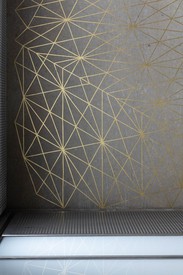
No Title
In an excerpt from his forthcoming monograph, Richard Wright pens a personal and philosophical text about painting.
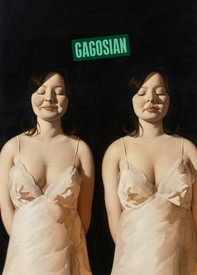
Now available
Gagosian Quarterly Winter 2022
The Winter 2022 issue of Gagosian Quarterly is now available, featuring Anna Weyant’s Two Eileens (2022) on its cover.
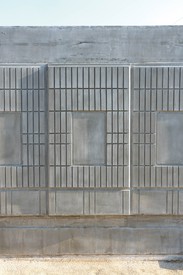
Rachel Whiteread: Shy Sculpture
On the occasion of the unveiling of her latest Shy Sculpture, in Kunisaki, Japan, Rachel Whiteread joined curator and art historian Fumio Nanjo for a conversation about this ongoing series.They address the origins of these sculptures and the details of each project.

